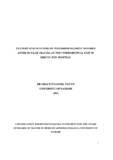| dc.contributor.author | Nguyo, Grace N | |
| dc.date.accessioned | 2017-01-05T07:15:42Z | |
| dc.date.available | 2017-01-05T07:15:42Z | |
| dc.date.issued | 2016 | |
| dc.identifier.uri | http://hdl.handle.net/11295/99034 | |
| dc.description.abstract | Background
Ocular trauma is a significant cause of monocular blindness worldwide. Eye injuries involving
the posterior segment have been a matter of concern particularly due to the related poor visual
outcome. These injuries require specialised intervention and follow up care to achieve best
possible visual outcome.
The study aimed to give baseline information on pattern of posterior segment eye injuries in
our set up, visual outcomes, as well as the determinants of visual outcomes.
Study Objective
To review the pattern and outcome of posterior segment injury after ocular trauma at the
vitreoretinal unit of Kikuyu Eye Unit.
Study Design
Retrospective case series of eye injuries involving posterior segment treated at Kikuyu Eye
Unit, a tertiary referral Eye Hospital in Kenya.
Materials and Methods
A structured questionnaire was the main data collection tool from hospital records. Data was
analysed using SPSS. Subject demographics, interventions done after injury as well as
outcomes after interventions were analysed using appropriate statistical tests. A 95%
confidence level was used.
Results
One hundred and six eyes of 102 patients were reviewed. Seventy three patients (71.6%) were
male and majority were in the 31-40 years age group. The most known circumstance of injury
was Road traffic accident in 9 patients (8.8%) with metal being the most common agent
causing these injuries in 15 eyes (14.7%). Seventy nine eyes (74.5%) were closed globe
injuries with retinal detachment and vitreous haemorrhage being the most common findings, at
49(46.2%) and 47 (44.3%) eyes respectively. Ninety nine eyes (92.5%) had surgical
interventions done, with PPV and silicon oil fill done in 39 eyes (39.40%) which had retinal
detachment. There was a marked improvement in the visual acuity from presentation and at
final review after various interventions (p<0.001) with 39 eyes (37.9%) having a final visual
acuity of 6/36 or better at final follow up. Retina was attached in 72.3% of eyes after retinal
detachment surgery at final follow up. Eyes which had more number of surgical interventions
xii
done had a higher chance of a worse visual outcome (p= 0.049).The median follow up time
was 5 months.
Conclusion
Ocular injuries involving the posterior segment were most common in young males. Surgical
and medical intervention is potentially vision saving in eyes with ocular injuries involving
posterior segment with good outcome being achieved in eyes with extensive injuries. | en_US |
| dc.language.iso | en | en_US |
| dc.publisher | University of Nairobi | en_US |
| dc.rights | Attribution-NonCommercial-NoDerivs 3.0 United States | * |
| dc.rights.uri | http://creativecommons.org/licenses/by-nc-nd/3.0/us/ | * |
| dc.subject | Pattern And Outcome Of Posterior Segment Injuries After Ocular Trauma At The Vitreoretinal Unit | en_US |
| dc.title | Pattern And Outcome Of Posterior Segment Injuries After Ocular Trauma At The Vitreoretinal Unit In Kikuyu Eye Hospital | en_US |
| dc.type | Thesis | en_US |
| dc.description.department | a
Department of Psychiatry, University of Nairobi, ; bDepartment of Mental Health, School of Medicine,
Moi University, Eldoret, Kenya | |


